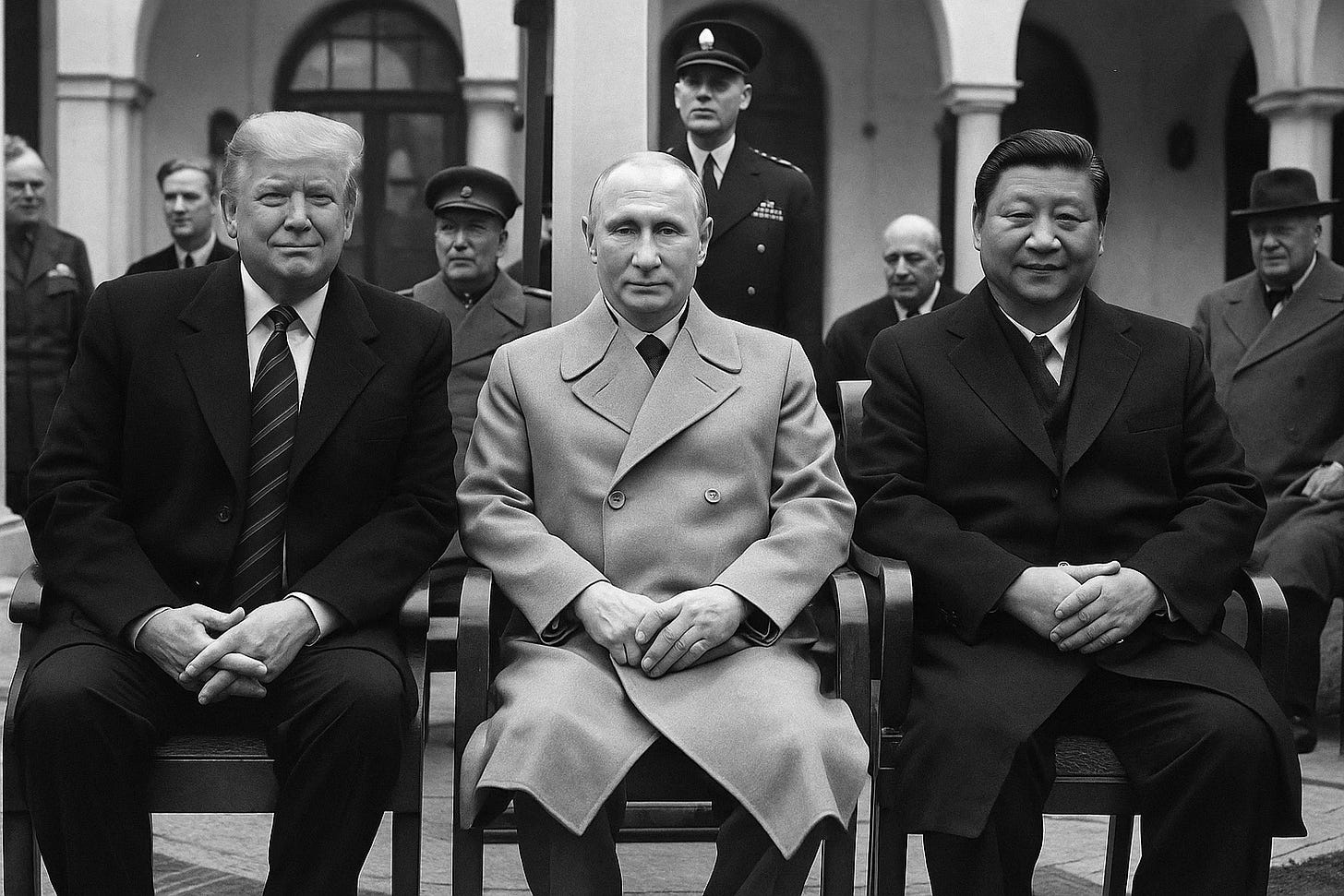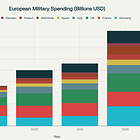How Europe Learned to Stop Worrying About Peace and Love the Bomb Again
Scholar Mikhail Minakov delves into how Russian aggression is militarizing Europe once more - but is the continent ready for war?
As European nations ramp up defense spending to levels not seen since the Cold War, a question long confined to academic debates has taken on urgent, real-world significance: what lessons can the continent’s postwar militarization teach us about navigating today’s escalating great power tensions?
The answer, drawn from fifty years of European nations’ defense spending patterns, is both sobering and instructive. The European continent has entered what might be called its second interwar period – the approximately twenty-five-year span from 1989/91 to 2014/22 now appears as a pause between epochs of militarization, much like the deceptive peace between 1918/22 and 1938/39.
This recognition matters because policymakers are making decisions about nuclear weapons, alliance structures, and defense budgets as if this militarization were a passing phase, but history warns us that these choices could shape the continent’s politics for an entire generation.
The European continent has entered what might be called its second interwar period
This analysis tracks the European continent’s military development across three distinct periods: the late Cold War consensus (1975-1989/91), the peace dividend era (1989/91-2014), and the current remilitarization from 2014 to the present. By examining defense spending data along with political changes in the West, Russia, and Ukraine, it shows how the continent’s brief experiment with demilitarization has shifted to bloc politics more rigid than anything seen during the original Cold War.
The story that unfolds is both a cautionary tale about the fragility of peace and a roadmap for understanding why true neutrality has become almost impossible in today’s Europe.
Europe’s Evolution of Military Spending, 1975-2025
Europe’s defense spending over the past fifty years reads like a grim fairy tale: war, then peace, and now war again—but unlike most fairy tales, this one is backed by real numbers and hard data.
Three distinct epochs emerge from the data like layers of geological strata1. The first, spanning from 1975 to 1989/91, can be called the Era of Expensive Certainty.
In those twilight years of the Cold War, European nations spent with the grim fervor of people certain the world could end by Tuesday. West Germany allocated 3.5 percent of its GDP to defense, Britain a strong 5.4 percent, while the Soviet Union—never one for half-measures—allocated an estimated 12 to 15 percent of its entire economy to the military-industrial complex.
Remarkably, this militarization received all-party support across the political spectrum. Social Democrats and conservatives alike embraced NATO’s 1977 call for 3 percent annual increases in defense spending, united in the comforting belief that mutual destruction required mutual investment.
Then came the second epoch: the Peace Dividend Period of 1989/91 to 2014, when European defense budgets collapsed with the sharp finality of a house of cards. Post-Soviet Russia’s military spending plunged eightfold—from about $260 billion in 1991 to just $16 billion by 1998. Germany’s defense spending fell to 1.4 percent of GDP, Spain’s to 1.1 percent. Politicians across the continent discovered they could simultaneously cut military budgets and win elections, a combination as hallucinogenic as it was unprecedented.
The third epoch began in 2014 with Russia’s annexation of Crimea, but it wasn’t until the 2022 invasion of Ukraine that Europe—and the wider West—fully shook off its long, peaceful slumber. Poland now devotes 4.2 percent of its GDP to defense, the highest in NATO. Germany’s €100 billion Zeitenwende fund represents the most dramatic military policy shift since 1945. Even the famously neutral Swiss have reconsidered their relationship with armed neutrality, providing Ukraine with support that would have been unthinkable just years ago2.
This table summarizes the evolution of continental military spending in just four columns and nine colors.
What stands out isn’t just the raw numbers, but the remarkable political consensus behind them. Across each period, European leaders—whether in the West or the East, the UK or Russia—appeared to favor militarization only when it commanded broad social and political support.
Political Evolutions Behind the Military Transformations
The numbers in defense budgets tell only half of the story; the rest lies in the strange political alchemy that transforms ideological enemies into trading partners, then back into foes again.
The three epochs that shaped Europe’s military spending were accompanied by political twists and turns so dizzying they could make Machiavelli queasy—like he’d been strapped into a roller coaster built entirely from the spikes and dips of this data on the graph below.
During the first period, politics ran on a comforting certainty: everyone knew who the enemy was. From Schmidt’s Social Democrats to Thatcher’s Conservatives, Western Europe’s leaders shared an almost religious devotion to NATO solidarity. Meanwhile, under Brezhnev, the Soviet Union began quietly abandoning its Global Proletarian Revolutionary ideals with all the enthusiasm of a bureaucrat ticking boxes—mechanically, thoroughly, and without conviction.
The 1975 Helsinki Accords, ostensibly about border permanence, human rights, and European cooperation, marked the moment when Soviet elites began their slow, unconscious retreat from world revolution3. What appeared to be diplomatic theater was actually an ideological surrender disguised as a peace treaty.
However, the European continent established a new institution, the OSCE, which represented a commitment to the indivisibility of security across the continent, regardless of the existence of the Warsaw Pact and NATO.
The second period saw one of modern history’s most astonishing political upheavals: the voluntary dismantling of a superpower. The USSR’s political elites didn’t just abandon communism: Gorbachev’s team abandoned the very concept of great power status. This was continued in post-Soviet Russia when Boris Yeltsin’s government slashed military budgets with the zeal of a reformed alcoholic discarding bottles.
Under the 1994 Budapest Memorandum, Post-Soviet Ukraine, Kazakhstan, and Belarus gave up massive nuclear arsenals in exchange for security guarantees that would later prove as reliable as a chocolate teapot—at least in Ukraine's case4. Western politicians, drunk on Francis Fukuyama’s ‘end of history,” convinced themselves that liberal democracy had achieved permanent victory.
In that victorious frenzy, the NATO alliance persisted and began expanding on the continent. The Russia-led CSTO appeared hopeless, while the OSCE morphed into little more than a ceremonial body.
The third period’s politics are defined indeed by what might be called the Great Military Reawakening. Putin’s Russia rediscovered its imperial ambitions with the reckless intensity of a midlife crisis, while Ukraine’s journey from post-Soviet disarray to a determined, EU-aspiring state became Europe’s most heartbreaking tragedy Meanwhile, Western Europe’s political classes have undergone startling transformations: Green parties now champion military spending, and Social Democrats have rediscovered a Cold War backbone once thought long buried—changes that in an individual might look like a personality disorder.
NATO and Russia, the latter backed by allies like Belarus, Iran, and North Korea, are once again splitting the continent, dragging Eurasian resources into the heart of European conflict.
The pattern is clear: European politics moves in generational cycles, with each new cohort certain it has outgrown the errors of those who came before.
Our Current Age of Remilitarization
What we are currently witnessing is not merely another swing of the geopolitical pendulum. As I argue in my recent book “The Post-Soviet Human”5, it marks the end of Europe’s second interwar period—an almost twenty-five-year pause between the end of the Cold War and the current conflict now metastasizing across the continent.
Like its predecessor in the first half of the 20th century, this interwar period was characterized by the dangerous illusion that war had been relegated to history’s dustbin, only to discover that history keeps rather poor records of what belongs where.
The current wave of militarization represents something more profound than a response to Russian aggression, though: it marks European nations’ reluctant acknowledgment that the peace dividend was always borrowed money. The continent that turned the 1990s military bases and military industrial units into shopping centers and migrant hubs now finds itself converting these centers back into military and industrial infrastructure. Sweden and Finland, long celebrated as paragons of neutrality, joined NATO with the eager conviction of reformed pacifists discovering the reassuring power of a sturdy lock. Even Switzerland—Switzerland!—is reconsidering whether armed neutrality requires more emphasis on the “armed” part.
Yet this wave of remilitarization reveals a troubling truth: the disarmament of the post-Cold War era was so comprehensive that none of the current warring nations can adequately supply their military ambitions. Russia’s vaunted military-industrial complex struggles to produce sufficient artillery shells and barrels to sustain its assault on Ukraine6. Ukraine, once a jewel of Soviet military industry, depends on Western factories for everything from ammunition to armored vehicles. Western European nations have discovered that decades of outsourcing defense production to cheaper markets left them strategically naked. The irony is exquisite: a continent rearming for war finds itself incapable of producing armaments for it properly.
More ominously, the European continent has quietly crossed several nuclear thresholds that would have horrified statesmen of the first Cold War. Britain spends £12,000 per minute on nuclear weapons while politicians speak casually of scenarios that were once unspeakable. France allocates 13 percent of its military budget to nuclear capabilities with the matter-of-fact efficiency of a grocer stocking shelves. Russia has made nuclear threats as routine as weather reports, while NATO debates raising defense spending to 5 percent of GDP—a level that would make Eisenhower blush.
The cruelest irony belongs to Ukraine, which traded the world’s third-largest nuclear arsenal for Budapest Memorandum security guarantees that proved as durable as morning mist. Now it fights with Western weapons against Russian aggression, a defending party in the kind of bloody war that European nations hoped never to witness again. The country that most thoroughly embraced disarmament has become the continent’s most militarized nation, spending 34 percent of GDP on defense—a figure that would have impressed even Stalin.
The European continent’s current remilitarization is not a return to Cold War logic but something new and potentially more dangerous: a continent that has forgotten how to manage military competition while remembering all too well how to escalate it. The second Europe’s interwar period is over, and like its predecessor, it ends not with resolution but with the recognition that the next great war has already begun. Whether Europe’s national and international institutions—designed for peace—can adapt fast enough to navigate a war they never anticipated remains unclear.
Mikhail Minakov is a political philosopher and scholar of international relations, specializing in Eastern Europe and Northern Eurasia. Over more than twenty years, he has combined research, teaching, and advisory work at leading universities and institutions in Ukraine, Germany, Italy, the United States, and Switzerland. As the author and editor of numerous books and articles, he explores the intersections of political systems, ideology, and historical transformation. Currently, he serves as DAAD Professor of Political Science at the European University Viadrina and as editor-in-chief of the Ideology and Politics Journal. More about his research can be seen at https://www.minakovphilosophy.com/
Mavris, G. (2024, August 7). Europa rückt militärisch näher zusammen. Die Schweiz macht mit – ein bisschen [Europe is moving militarily closer together. Switzerland is joining in – a little bit]. SWI swissinfo.ch. https://www.swissinfo.ch/ger/aussenpolitik/europa-r%c3%bcckt-milit%c3%a4risch-n%c3%a4her-zusammen-die-schweiz-macht-mit-ein-bisschen/87438261
Sarotte, M. E. (2014). The collapse of the Berlin Wall: The culmination of a revolution. Princeton University Press. https://assets.press.princeton.edu/chapters/i11140.pdf
Budapest Memorandum on Security Assurances. (1994, December 5). United Nations Treaty Series, 3007, I-52241. https://treaties.un.org/Pages/showDetails.aspx?objid=0800000280401fbb; Budjeryn, M. (2014). The breach: Ukraine's territorial integrity and the Budapest Memorandum (Issue Brief No. 3). Nuclear Proliferation International History Project, Woodrow Wilson International Center for Scholars. https://www.wilsoncenter.org/sites/default/files/media/documents/publication/Issue%20Brief%20No%203--The%20Breach--Final4.pdf
Minakov, M. (2024). The Post-Soviet Human: Philosophical reflections on social history after the end of Communism. ibidem-Verlag.
Boulègue, M. (2025, July 21). Russia's struggle to modernize its military industry: How sanctions, war and 'innovation stagnation' are weakening Moscow's capabilities. Chatham House. https://www.chathamhouse.org/2025/07/russias-struggle-modernize-its-military-industry






